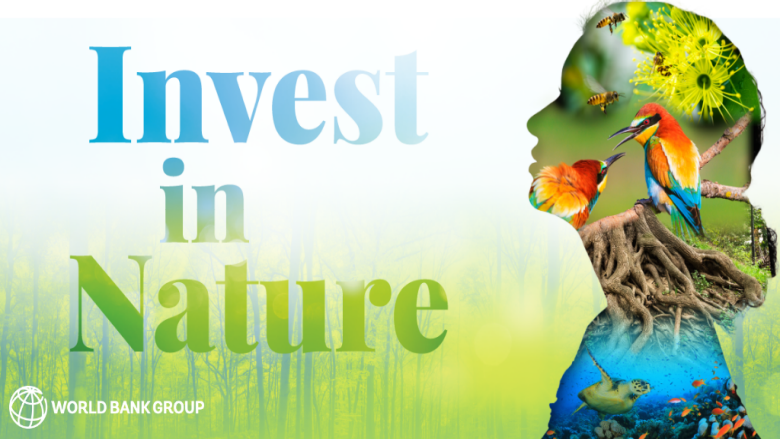To create a world free of poverty on a livable planet, the World Bank is mainstreaming nature considerations into economic policy, development programs, and strategic sectoral investments. Biodiversity is the fabric of life. Ecosystem services provided by nature are the foundation of human well-being, economic prosperity, and development. This is why the World Bank has been at the forefront of financing nature for decades, providing integrated financing solutions for the conservation and restoration of nature, supporting institution-building, and developing tools and analytics that help provide evidence-based knowledge. Increasingly, attention is shifting to economic sectors and policies beyond the purview of environmental ministries – for example, urban development, agriculture, disaster risk management, and water management – to address the drivers of nature loss and promote sustainable sector practices.
The World Bank is committed to support countries to adopt nature-smart development approaches that protect nature while ensuring it remains an engine for growth and jobs. The Bank is supporting the implementation of the Kunming-Montreal GBF (KMGBF) adopted in December 2022 at the 15th Conference of the Parties of the Convention on Biological Diversity (COP-15). Our holistic, cross sectoral work already contributes to GBF ambitions across numerous goals and targets.
Support in three strategic areas can unlock impact at scale: integrating nature into countries’ development policies and strategic investments to attain a green, resilient, and inclusive development; scaling up finance in support of nature from all sources, including by ‘greening’ broader public and private finance; and better integrating investments in nature with those in climate change adaptation and mitigation.
Bringing nature at the center of green, resilient, and inclusive development in countries means defining how economic and financial incentives and regulations can better integrate longer-term sustainability considerations across sectors. This includes opportunities to boost the economy and deliver positive environmental outcomes simultaneously through nature-based solutions. The modeling and analytical work on nature the World Bank has developed provides insights on economic impacts of different policy scenarios, helping governments in this endeavor.
More, better, and more accessible finance is needed to halt nature loss and support high-impact projects. The Bank is the leading multilateral financier of biodiversity. It provides an array of financial tools to support biodiversity and ecosystems, from concessional IDA funds to blending and innovative tools that contribute to mobilize more “green finance.” At the same time, it works to develop new standards and provide data and decision-support tools for governments and financial institutions to shed light on nature-related risks and opportunities is contributing to “greening” global finance.
Nature is also at the core of World Bank Multi-donor Trust Funds (MDTF), which strategically raise resources and concessional funds to blend, de-risk, and pilot new financing financial instruments, and provide analytical foundations for investment in nature:
- The Global Program on Sustainability (GPS), which builds on the WB-led WAVES partnership, has been working with countries to incorporate the economic value of natural capital and the risks associated with its degradation in decision-making processes. We are also working to make sustainable finance part of the solution, engaging with the financial sector to support a better integration of risks and opportunities associated with natural capital into investment decisions and reporting.
- Through PROBLUE, our program to promote the development of integrated and sustainable economic activities in a healthy ocean, we are ramping up work to address marine plastics and other threats to ocean health, like overfishing and the destruction of natural habitats such as mangroves.
- The World Bank also oversees PROGREEN, a program that addresses challenges to land-based natural assets threatened, for example, by land-use change, land degradation, desertification, and illegal logging.
The three trust fund programs focus on ocean and seascape issues, forest and landscape issues, and environmental and economic issues. All three support countries through knowledge, capacity building, grants and investments—and strive to respond to nature, economy, and livelihood needs of country clients. The MDTF’s are accelerators that gain and add value by focusing on key issues of nature and finance, building on the Bank’s country engagement model, blended finance approaches, efficient operating models, and ability to engage upstream at the policy level and downstream at the investment and implementation level.
Nature is also being integrated into climate action. The World Bank Group Climate Change Action Plan (CCAP) recognizes that a combined approach that addresses both climate and nature risks is needed. To help tackle these crises in tandem, the CCAP is stepping up investments in nature-based solutions and integrated management of ecosystems, and supporting development of wealth accounting, economy-ecosystem-climate modelling, as well as other efforts to bridge the biodiversity financing gap. The Climate Change Development Reports (CCDRs) further look into synergies between nature, climate, and development. For instance, Ghana’s CCDR points to the benefits of blue ecosystems to protect against the impacts of sea level increases.
Finally, given the complex links between people and land, the World Bank has adopted a more integrated landscape approach that simultaneously works on improving the resilience of both ecosystems and livelihoods. Through the Environmental and Social Framework, the World Bank screens all its investment projects under the lens of the standard on “biodiversity conservation and sustainable management of living resources,” applying a precautionary approach to project design.
Last Updated: Apr 12, 2024

